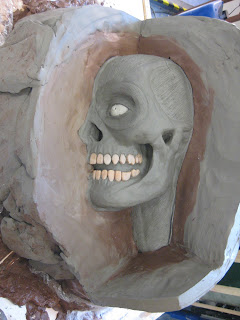I started by adding his hair. I knew I would have to use a lot of hair because I made his head slightly larger than a normal so I decided to use nylon hair extensions. I wanted to make sure that it wasn't going to look like a wig so I bought three different shades: black, dark brown and brown. I mixed the hair together and cut it to the length I wanted. I stuck it on using latex:
Once I had attached the hair as far up as I thought it needed to be, I started to punch the hair it at the top so that it would make it look more realistic and it wouldn't be as flat. I also gave him hair in front of his ear but because this was shorter, I used latex to glue it on rather than punch it in as this would have made it stand out more than I wanted it to:
Whilst doing this, I added a bit more paint detail on the face, added some teeth (I made new ones from Sculpey to fit in the latex cast as I wasn't pleased with the earlier ones) and gave his them a coat of clear Glaze to make them look more shiny (I had noticed from looking at human teeth that had been removed by a dentist, the tooth was surprisingly shiny and the root was very dull in comparison):
I made them bright white as described in the book but they looked a little absurd so I dulled them down a bit to make them look a little more 'dead'. Also, because I made new teeth, the width of some of them weren't the same as before so when I glued them in place, there was a gap at the back. I used the bone coloured latex to fill in these gaps:
I added more paint detail:
Then, I styled his hair to make it look like how I envisioned it:
I was pretty happy with it! Now, to make the latex flap on his head a feature, I added stitched around the sides of it. To make them look more believable, I added dark red paint on either side to act as blood:
I didn't finish off the stitching as I hadn't done the eyebrow yet. This was the head so far:
So now I had to punch in the eyebrow using individual strands of hair so that I could finish the stitching on his forehead. I also neatened up the hair around the middle of his head by punching smaller amounts of hair closer together right down the middle:
Now all I had to do was add the muscle detail on the unfinished side of his face. After experimenting slightly, I came to the conclusion that the best way to create the muscle for his face was to use cling film covered in the muscle coloured latex I had created so that I could mold it to the shape I wanted it and it would give it an interesting texture. To pad out the muscle on his jaw, I added a cotton ball underneath:
This was his finished head so far, I was very pleased with how it had turned out! Of course, I still had the eyes to add but I would do this at a later date. For now, I needed to start on creating his body.






























































